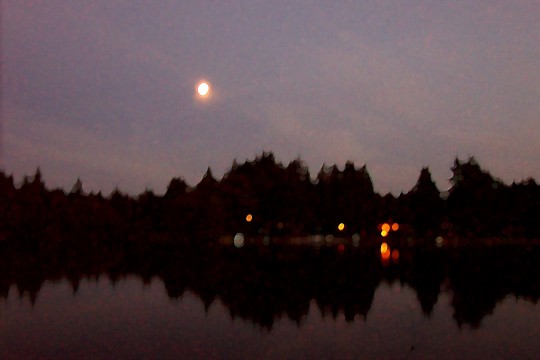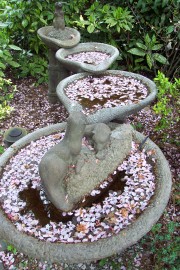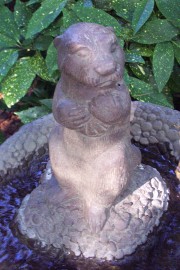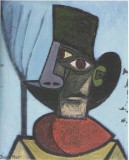Life at the Lake
a diary of living at a small lowland lakeWHAT IT'S LIKE

Early moonrise over Lake Ketchum
|
Archive Search |
| Links |
|
and s-integrator |

A bit of Sumi nonsense. These "characters" do not translated into anything meaningful. How wonderful!
The key word in Sokei-An's book, Zen Pivots, of course is "pivots." I said in yesterday's blog that, though Japanese, he was most American, and lived and taught here off an on during and after WWII.
It is interesting, and illustrative, because it is so American a word and notion. A basketball player "pivots" before he shoots, and the center is often called The Pivot, as is the position on the floor he is standing when he does this. Of course basketball is not exclusively an American sport. It is world-wide, and players from many countries now enter as so-called "amateur" athletes.
But the concept behind Buddhism is much more illusive and complex. It is based on the idea of emptiness and nothing and silence. The concept of silence is very difficult and has been likened to "mute thunder." And Sokei-An has a unique way of expressing this "no-word" or "said nothing." He uses the word, SILENCE, and writes it in small caps.
He states, "In the beginning, when I was giving lectures here in Hew York, when I sat in SILENCE the audience thought the Reverend had forgotten a word and is thinking about it." [Page 148] But that was not the case.
SILENCE is the answer. And there were numerous illustrations of the Buddha and enlightened monks, or master, who followed, using this word, this stance, as a reply to questions of a koan-nature from monks, or students.
It is often misunderstood. And I cannot start to explain it, for I don't understand it myself, except to say, it hints at what we Westerners call eternity. One might say it is the universe before the Big Bang. And it is the universe after the Big Bang that created it, as well.
Soei-An says the Buddha's answer of SILENCE is the pivot on which enlightenment depends. It is easily misunderstood. To continue in this framework of double-talk, or riddle (or nonsense), the answer is no answer. SILENCE speaks worlds.
Enough for today. (Gotta go clear my head.)
- - Comments ()
...

Otter Fountain, with its four basins covered with cherry blossom petals
Yesterday I wrote facetiously about the uppermost otter in my fountain being The Buddha. Then, what are the roles of the other two otters in basin four, which houses the water pump? How joyful they look, sporting on their rock.
They are his companions, his brothers (or perhaps his sisters). They are Bodhisattvas. They are at play, working on their Dharma.
I take all of this lightly. As a friend, Martha Weinstein, once said about her husband and my flyfishing for steelhead trout, "You can be serious without being solemn." Ah, Martha, what truths you spoke, though neither Ed nor I still follow the steelhead mantra.
As Sokei-An wrote in Zen Pivots—a very American book, incidentally—"Taoism is China. Shinto is Japan. What will the religion of America be?
"This continent has rich soil, good climate, fat horses, and beautiful women. It is very different from the densely populated Europe it imitates. Yet there are still open spaces in America's vast West, empty except for sagebrush, where you can ride for half a day and see only a few cows or prairie chickens. There is something of the greatheartedness of the American Indian in its people's generosity. Tao is already here. Here, Christian Love and Chinese Tao meet.
"I think of America like this: It could be the meeting round for the religions of East and West. If Tao can be incorporated into the life of America, what a wonderful country it could be!" [Written about 1945,p. 43]
- - Comments ()
...

The Buddha? Maybe, but only on Mondays
In America it is not fashionable to be a Buddhist. In fact, it's downright unAmerican. You got to be a Christian here, and these days it is best to be Born Again. You will have lots of company, and most of it is flying the flag and showing a large amount of hostility. It's only natural, seeing that we are at war. The enemy is World Terrorism.
Funny, but since my college days, back in the Horrible Fifties (not so awfully different from today, by the way), I've had an interest in Buddhism. That was back in the early days of American Zen and Alan Watts. Jack Kerouac—who seems to have understood only an introductory course smattering of it—popularized some of its ideas (satori, for instance) and founded a whole movement of Beatniks, who wandered the country in the manner of mendicant monks, but smoking grass and dropping acid.
Ah, yes.
I've read in Zen, off and on, since then, and, most recently, in Sokei-An's Zen Pivots, and Nyogen Senszaki's, The Iron Flute, 100 Zen Koans. In my blog future I may quote from these because I find some of the ideas both American and challenging.
So, anyway, I am sitting by my Otter Fountain, listening to the music of water splashing ("one-hand clapping?") and trying to read, not meditate (which I don't do), and being bothered by sunlight dappling my page and the wooden bench being hard on my back, when suddenly I look up.
The uppermost otter—as are the other two—is cast in some kind of cement. It has a whirred gray finish, quite rough. I look up at the little guy, who sits atop a spigot and hose connection that splashes water from basin one to basin two, often spilling more than a drop, and I think, "This little guy is the Buddha."
It isn't that he looks like Buddha, which he does. He is Buddha born again, but in a kind of crazy, impersonal direction. The antithesis of ordinary ideas of the transmigration of souls or even reincarnation.
The thought has been with me ever since. Perhaps that is Enlightenment.
What is the difference, by the way, between Enlightenment and Another Dumb Idea?
- - Comments ()
...

Dora Marr, "Portrait of Picasso in a Black Hat," c. 1937
We are not quite done with Dona and Pablo. Maybe we shall never be.
It was one of the great collaborations of all times. I mean, what famous models turned right around and painted their lover/artists? And even if they did, did so so well?
When invited, Maar went to Picasso's Paris studio, and when she was not busy posing, picked up one of the famous artist's brushes and slapped some oil paint on an adjacent canvas. Like many beginners, she looked to the works of painters she liked, admired, and imitated them, but soon broke away with a vision and technique of her own.
The audacity of attempting to beat Picasso—already world-famous—at his own game! Impossible, of course.
Or was it?

Dora Maar, the "Weeping Woman," not weeping but looking pensive and lonely, cut out of a group portrait taken by Man Ray
- - Comments ()
...